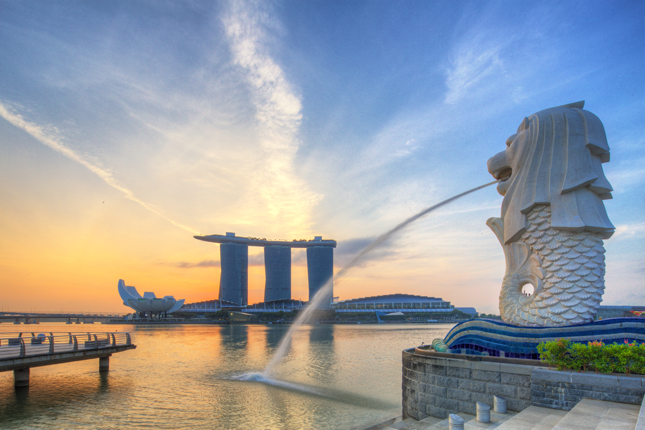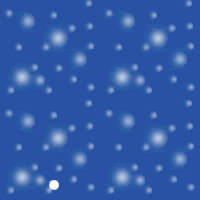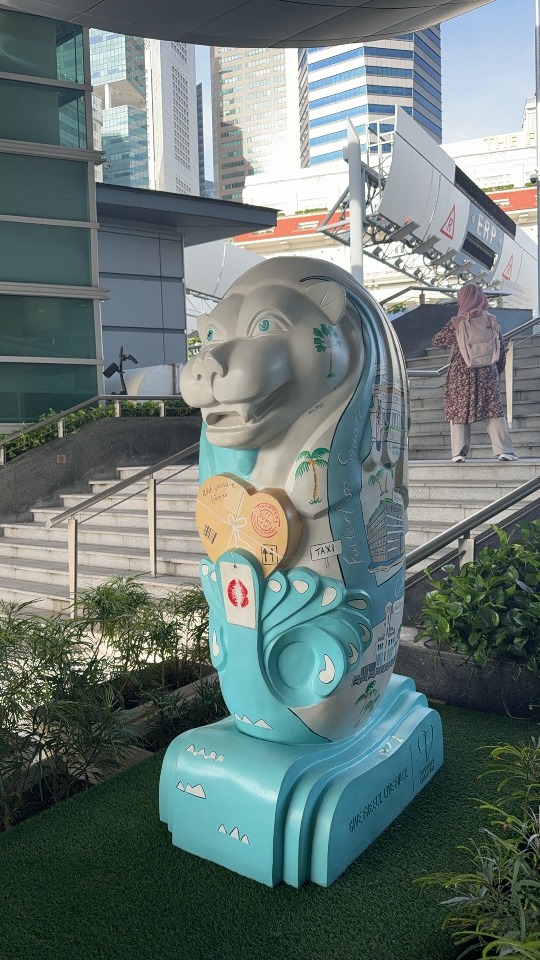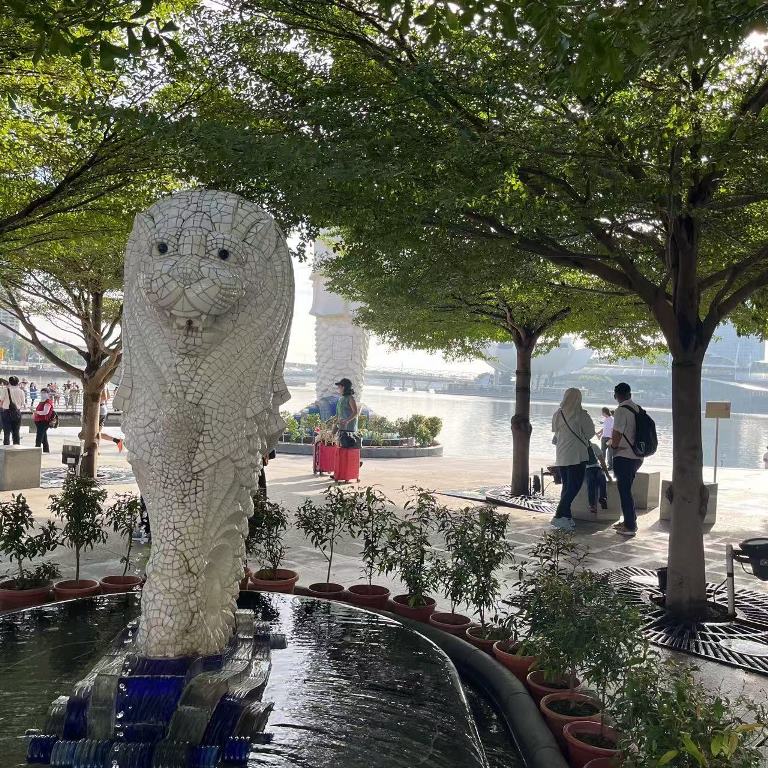Merlion

_resize.jpg)
![]()
|
TOUR SKILLS
|
| STORY | ||||
|
LITTLE RED DOT
|
|||
|
|
|||
|
||||||||||||||||||
|
鱼尾狮公园 鱼尾狮公园是新加坡著名地标。(档案照) 新加坡河上游与亚历山大水道(Alexandra Canal)相连,但现在一般以金声路为分界,作为新加坡河的起点新加坡河下游是通往滨海湾的主要河流. 旅游船穿过安德逊桥前往滨海湾的鱼尾狮.新加坡著名地标鱼尾狮,就矗立于新加坡河口.口吐水柱的鱼尾狮高约八 米8.6m,重达70吨,是新加坡已故雕塑家林浪新的作品。• 鱼尾狮原址矗立在安德逊桥旁的河堤上,后迁往浮尔顿侧。 • 1972年9月15日正式开放,开幕典礼由前总理李光耀先生主持。 • 2002年9月15日起,守护新加坡河口30年的鱼尾狮搬迁至浮尔顿一号旁的填海地,占地面积2500平方米,约为原址的4倍,由新加坡旅游局耗资750万新元建成。 • 狮头代表传说中的狮城(新加坡),鱼尾象征古城淡马锡,代表新加坡从小渔村发展起来,鱼身象征与新加坡河的密切关系。 • 鱼尾狮原本是1964年成立的新加坡旅游促进局的标志,1972年,当时的新加坡旅游局决定把它做成雕像,竖立在新加坡河的河口。 • 设计者是前范克里夫水族馆馆长伯纳。 由我国著名雕塑家林朗欣先生和他的两个儿子共同雕刻而成。 在新加坡河口的鱼尾狮公园(Merlion Park),是新加坡著名地标。外国游客来到新加坡,自然不会错过这个景点。 2025 年 2 月 11 日和 12 ,鱼尾狮雕像将被脚手架覆盖以进行清洁清理 位于鱼尾狮公园的标志性鱼尾狮雕像将于 2025 年 2 月 11 日至 2 月 12 日进行清洁清理和维护。 新加坡旅游局 (STB) 在 1 月 6 的媒体咨询中表示,在清理和维护期间,鱼尾狮雕像将被脚手架覆盖,无法拍照。 与此同时,欢迎公众与附近的鱼尾狮幼崽雕像合影,该雕像也位于鱼尾狮公园。
鱼尾狮雕像定期进行维护和清洁,2023 的一次清理工作最多需要 12 周。 最近一次清洁是在 2024 年 12 月 4 日进行的。 鱼尾狮公园后面,有一座横跨河面的直桥——滨海湾桥(Esplanade Bridge),鱼尾狮在1972年落成时,是矗立在这座桥的另一侧。当时还没有这座桥。桥建成后,阻挡了鱼尾狮原本宽阔的视野。新加坡旅游局在2002年,将鱼尾狮迁移至桥的这一侧,即新加坡河口的滨海湾现址。 最靠近的地铁站:莱佛士坊(Raffles Place),H出口 +++++++++++++++++++++++++
• 鱼尾狮原址矗立在安德逊桥旁的堤岸上,后迁往浮尔顿一侧。
|
|
The Merlion is a renowned symbol of
Singapore that combines cultural significance with modern design. Here
are its key features: +++++++++++++++++++++++++++++++ • The Merlion stands at its original site is located on the embankment next to Anderson Bridge before moving Fullerton side. • On September 15, 1972, the official opening ceremony was presided over by former Prime Minister Mr. Lee Kuan Yew. • Starting from September 15, 2002, the Merlion, which had guarded the mouth of the Singapore River for 30 years, moved to the reclaimed land next to One Fullerton, with an area of 2,500 square meters, about four times the size of the original site, and was completed by the Tourism Bureau at a cost of 7.5 million Sing Dollars. • The lion's head represents the legendary Lion City (Singapore). The fish tail symbolizes the ancient city of Temasik, and represents that Singapore developed from a small fishing village. The fish body symbolizes its close relationship with the Singapore River. • The Merlion was originally the logo of the Singapore Promotion Bureau established in 1964. In 1972, the then Singapore Tourism Bureau decided to make it into a statue and stand it at the mouth of the Singapore River. • The Merlion is about 8.6 meters high and weighs 70 tons. It was sculpted by Mr. Lim Langxin, a famous sculptor in our country, and his two sons. • The designer is Berna, the former director of the Van Kleef Aquarium.
|
|
鱼尾狮, 吃立在新加坡安德逊桥旁堤岸的鱼尾狮,形像生动逼真, 吸引了众多的旅客驻足观赏。 鱼尾狮是旅游促进局耗资十万元兴建的。 高约8公尺 8M,由雕刻家林南生先生和他的两名孩子共同雕塑的。
它的内容是“鱼尾狮象征新加坡“ 这个名字的来历:
|
| 鱼尾狮/公园 各位贵宾,您面前的这座雕像就是大名鼎鼎的鱼尾狮,鱼尾狮公园也是因它而得名。熟悉新加坡的朋友可能知道,新加坡也叫狮城,新加坡的城市标志则非鱼尾狮莫属。那么这些形象到底源自哪里呢?这背后有传说,也有一些新加坡历史的渊源。鱼尾狮的鱼尾身代表新加坡曾经是座渔村,当时新加坡被称为淡马锡 (海滨小镇的意思)。狮头代表新加坡的原名“Singapura”,也就是梵文中”狮城“的意思。传说,苏门答腊巨港王子桑尼拉乌他玛 (Sang Nila Utama) 在出海时遭遇风暴,意外登录新加坡。在新加坡河的河口处,这位王子看到了一只奇特的生物,他认定是一头狮子,所以就称新加坡为“狮城”。 鱼尾狮雕像搞8.6米,重70吨,口中源源不断喷出水柱。鱼尾狮最开始位于新加坡河河口的位置(用手指一下鱼尾狮雕像的旧址),由关世强先生设计、雕塑家林浪新先生花费两年的时间精心制作,于1972年由时任总理李光耀先生揭幕。随着滨海湾桥 (Esplanade Bridge) 于1997年建成,站在海滨湾已无法清楚的观赏到鱼尾狮雕像全貌,因此雕像随后迁至现在我们站立的地方,从新加坡富丽敦酒店的前方,往滨海湾方向瞭望。面向东方大海,从华人信奉的风水角度来看,是非常吉祥的朝向,这紫气东来的好运果然被美丽的鱼尾狮源源不断的带进了新加坡。在短短不到五十年的时间里,新加坡也迅速华丽转身,从原来的一个平凡的小渔村,成为兼具国际地位和经济实力的“花园城市“。而如今的新加坡,已经不在满足于已经达成的“花园城市“的称号,它又有了更进一步的目标--”花园中的城市“,相信大家通过这几天的旅程,已经可以感受到新加坡在这方面所做的努力和已经取得的成果。 鱼尾狮公园内还另有一尊小鱼尾狮雕像,也是由林浪新先生花费数月精心制作。由于大鱼尾狮的位置紧挨岸边,面朝河口,旅客身处此地无法看到其正面,因此才决定在它背后不远处竖立这尊小鱼尾狮。跟大鱼尾狮相比,小鱼尾狮有着诸多的不同。首先,它更加的小巧,高两米,重三吨;其次,在造型上,它嘴角上扬,显示出和善乖巧的风格,软化了大鱼尾狮威严庄重的神情;第三,在制作材料商,小鱼尾狮的外壳铺上的是景德镇瓷碗敲破之后的碎片,跟大鱼尾狮的石膏敷上透明胶进行区分,而且,在混凝土制作时,加入了少量的糖以达产生更好的黏性,因此,可以说小鱼尾狮是甜的哦! 新加坡全岛经批准的鱼尾狮雕像共有七座,鱼尾狮公园的这座最原始的鱼尾狮雕像以及一旁的小鱼尾狮雕像是最为出名的两座。大家在接下来的行程中多加留意,还可见到其他地方各具风格的鱼尾狮雕像:比如格兰芝路 (Grange Road) 附近新加坡旅游局大楼 (Tourist Court) 前有一尊,花柏山 (Mount Faber) 顶部也有一尊。大家有时间的话,可以去探索和比较一下不同风格的鱼尾狮。
|
|
|
|
|




